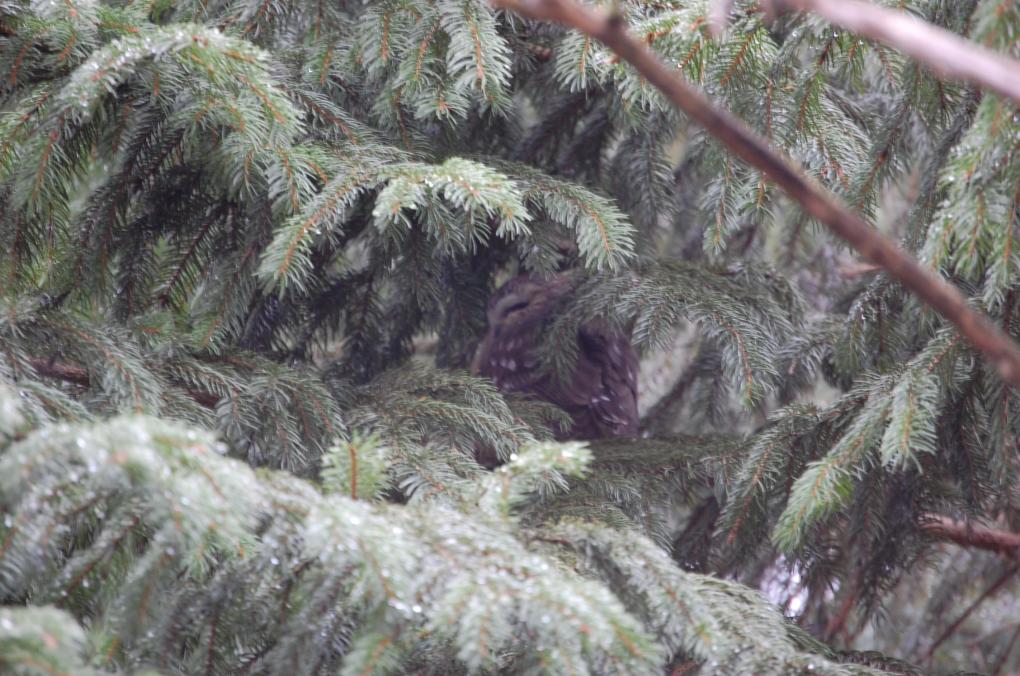The Cornell Lab Bird Academy › Discussion Groups › The Wonderful World of Owls › Young Owls Grow Up
-
I absolutely love birds. From backyard birds, parakeets, parrots, chickens, ducks, and especially birds of prey like Owls and Falcons. The lifestyle of owls are similar to falcons because they are predators, eating small animals and hunting from above. They are different from birds like chickens and ducks due to the fact that they don't eat the same thing, nor do they stay in groups. They are also nocturnal and regurgitate their food instead of passing it through their bowels.
-
OOPS! Sorry, but in my previous post I meant that LONG-eared owl, not short-eared owls, are know to roost together in the non- breeding season!
-
I found the fact that owls are such loners interesting and quite a contrast to the many birds who flock and move together during the non-breeding season. I had always had an idea that owls were loners, but did not realize the degree to which they are loners. It was interesting that, as an exception, short-eared owls are know to form communal roosts. In regard to family life, the concept of the young "branching" was interesting. I am really enjoying this course. All kinds of new information!
-

 Found these northern saw-whet owls in an aspen tree at South Lake Tahoe, 7/31/14
Found these northern saw-whet owls in an aspen tree at South Lake Tahoe, 7/31/14 -
similarities between owls and other birds: They nest, they lay eggs, raise chicks, defend territories, fly With the exception of flightless birds. Differences between owls and other bird species is : Owls are nocturnal, what they eat is different from, for example.... Blue Birds, Cardinals, Finches, etc. (the seed/fruit eaters and totally different from what Hummingbirds eat. How they fly silently is different too!
-
Their song/call is so different from other birds. Hearing one at night is always a surprise and a treat. It's a mysterious and almost eerie mood-setter, especially when you can't spot it, visually. Their big eyes also seem to dare you to a round of combat, what with their forward-facing gaze.
-


 Watching grea horned owls nest on our campus has really helped me understand their life cycle better. These are a few photos of the owlets.
Watching grea horned owls nest on our campus has really helped me understand their life cycle better. These are a few photos of the owlets. -
I have seen few owls in my life which is due to where I live and my habits and some other things which I have little control over. As I have indicated earlier, the only owl that I have been lucky to see in my neighborhood is the Great Horned Owl in December of two different years. I will compare the owl to a frequent visitor to my feeding station in my back yard: the red-bellied woodpecker. As I have come to find out as a result of this course is the relationship between woodpeckers and owls. Owls need woodpeckers for their abandoned nests as few owls build their own. Woodpeckers are daytime birds and many owls are nighttime birds. Owls are birds of prey and woodpeckers are not. Someday, I hope to have a chance to view such great owls as the Great Gray Owl, the Spotted Owl, and the SawWhet, to name a few. I would love to gaze upon a Snowy Owl but I live in Texas, so not likely that I will see one unless I travel, which I hope happens some day. I love owls for their place in the wilderness, which we need to preserve to the benefit of all.
-
I keep thinking about how the Northern hawk owl looks so much like the northern Harrier, one of my favorite raptors. I do so love their ability to move so incredibly slowly, low over a field, appearing to defy gravity as they barely move forward but barely flap their wings. I like the owls that hunt that way, I suppose. Especially impressive is the Great Grey Owl when he glides over the snow listening for prey.
-
The owls are birds and therefore do the same things that the vast majority of birds do. But they differ by their mainly nocturnal habits, they are not very sociable (although there are exceptions), they reproduce and feed in a very particular way. Parents are very protective, even against another predator. The pellets are very interesting because we can know what owls eat.
 Baby of the Short-eared Owl in the Sabana de Bogotá, Colombia
Baby of the Short-eared Owl in the Sabana de Bogotá, Colombia -
Even baby owls look cute with those fluffy feathers and forward eyes. I like very much the spectacled owl and the burrowing owl babies. It is surprising how they pass from that to an adult. The pellets did not seemed very disgusting to me. I also did not knew owls migrated. I only knew the burrowing owl did it. I even knew less that they moved from Europe to Asia.
-
Though owls engage in the same activities as most birds (hunting, raising young, etc.), their most notable differences are that they are nocturnal, do not often build their own nests, regurgitate sizable pellets, and are solitary. However, some of these characteristics are not strictly confined to owls (though they are commonly associated with them). For example, most raptors have pellets and are solitary. Some herons are also nocturnal.
-
Owls are way more solitary than other birds but this works in their lifestyle because than they would be noticed more and avoided or driven off. Their sit and watch technique reminds me of flycatchers but they are able to do it in the dark which is incredible. Their secrecy is incredible! Does anyone have any tips on how to find owls especially the small ones?
-
The perch-and-pounce technique kind of reminds me of when flycatchers wait for an insect to fly by before they quickly dart towards and grab their prey. However owls can do this in complete darkness using only their hearing.
-

-
The wings of a robin are more slender and pointed , the owls have rounded powerful wings and the feathers up close on the owl are soft not like the robins stiff feathers. Owls are powerful hunters. The food selection of robins is different then some owls, they eat small insects. Robins build their nests but owls are cavity nesters often using a banded nests.
-
Owls perform all the same activities as other birds (raising young, finding food, and claiming territories, to name a few). However, their ways of doing so are tailored to their specific niche--nocturnal predation. I see many similarities between owls' lives and those of other birds of prey. They catch live food, engage in strenuous hours of hunting, and teach their young to hunt as well. Also, they share many of the same structural design features (talons, strong beak, and powerful wings). However, an obvious difference between owls and these other birds is their nocturnal nature. Owls are specially designed to live in the dark, and they do so excellently!
-
It was interesting that many owls do not travel widely, and can find their food - in many cases - without migrating far away. It was also interesting to learn that they are more solitary, and often don't interact much - even when they are together. I really enjoyed the resource about the Snowy Owl Baltimore. He is a migrator, and it was rather humorous to follow the path of some of his southern (south of the Arctic that is) visits. What a wide variety of locations he traveled. A very versatile bird!
-
I hadn't ever really considered before what loners owls are. It occurs to me that humans solving a problem can be categorized according to owl hunting behavior: sit and watch or go after it!
-
I was surprised that owls leave the nest before they can fly; the whole concept of branching. It was interesting to watch that one owl climb the tree!
-
I found the pouncing, preying practise and the branching incredible. Owls do seem like loners and very interesting how they don't make their own nests and how their heads don't actually move 360 degrees - a great illusion!!
-
The Owl Family, seems to be more private, and almost scared/paranoid, of beholders. One thing I want to do, is get a picture of a raptor, that seems easier to photo, than Owls and Hawks/Eagles. A Vulture cleaning a carcass. I do not think I will ever see an Owl, that will stay still. I have seen them perch, and fly away. And like an Eagle, or Hawk, they do not seem to like being in the eye of a beholder. What is it about some birds, that they do not get scared away. I have seen Swans, right next to me, and other Swans have eaten,out of a persons hand, even in the wild. An Owl is scared, like a smaller bird. And they are never near people. Even skittish small birds, eat near people, and will eat out of a persons' hand, if food is presented. Why is such a strong bird, so skittish ? And just in general, what makes a bird scared, or not, of people ? Why can a Swan, be within a few feet of you ? And a Goose too. And other birds be completely scared ? Owls also seem to have more personality to them. The pics I have seen, almost show human moods to them. Not blank, nor plain. Like they are wearing a fear, and a care, on their sleeve. Not a plain bird.
-
Owls definitely work alone....but that is similar to most raptors. It is also interesting how they are able to find their prey even in the winter time, unlike some song birds that have to travel in order to continue to feed. Do owls greatly change any of their diets for the winter time? I know some songbirds like the Eastern Bluebird change their diets for the winter months. I was very lucky this weekend to see a Northern Saw Whet Owl that likes to come to the Cleveland Lakefront Nature Preserve but other than that I have only see Barred Owls. Owls are so much harder to find...not only because of their nighttime lifestyle but also when we can see them during the daytime, their feathers SO greatly camouflage them! Plus they are normally so still as they are sleeping. Looking forward songbirds, you are always drawn to the movement of them.


-
Wow! If you hadn't mentioned there was an owl in the photo (and provided a close-up), I wouldn't have seen it!
-
@Karrin Recently I was birding in Green-Wood Cemetery here in Brooklyn and one of the more experienced among us spotted a Northern Saw-whet perched low in a yew shrub. We broke into small groups of three to move in closer for a glimpse. I was studying and studying, thinking I could not see it even though I was gazing exactly where our guide was instructing us to look! I was just about to give up when I realized what I had been thinking was a stick was in fact the Saw-whet angled in such a way that it's breast looked like a white stick in a gap area of the yew shrub. All at once, my eyes caught sight of the owls CLOSED eyelids and the whole bird suddenly became clear to me.
-
-
What I found interesting and did not know was the "Branching" behavior of owls. Although I knew birds will eventually leave the nest they hatched in, falling out of the nest may be a sure way to be entering the "food chain" as a prey. Watching the video of owls climbing back up a tree and getting themselves to safety is not something all bird species may be able to do. Strong legs and claws are sure helpful even at such young age.
-
Agreed that was interesting to read and then see. Again, it helps that some of those owls are apex predators; although for some young maybe that is when they are snatched by other predators.
-
-
I've been participating in Cornell's Feeder Watch and have seen a variety of different birds, unfortunately no owls. The birds range from my common, resident birds (they are here all year round, Blue Jays and Northern Cardinals) to wintering birds, such as Pine Siskins and American Goldfinches. All of these birds are different from owls because they are here feeding during the day, whereas owls are nocturnal; they are mostly seed eating birds (the wrens and some others also like spiders and bugs); and they are not predatory, although the Pine Siskins can be bullies when it comes to feeders. I love the differences in feathers! There are some owls whose wings have feathers that don't make any sound as they sweep towards their prey, while others such as the Snowy Owl that have wings needed for strength instead of stealth. Birds are very diverse!
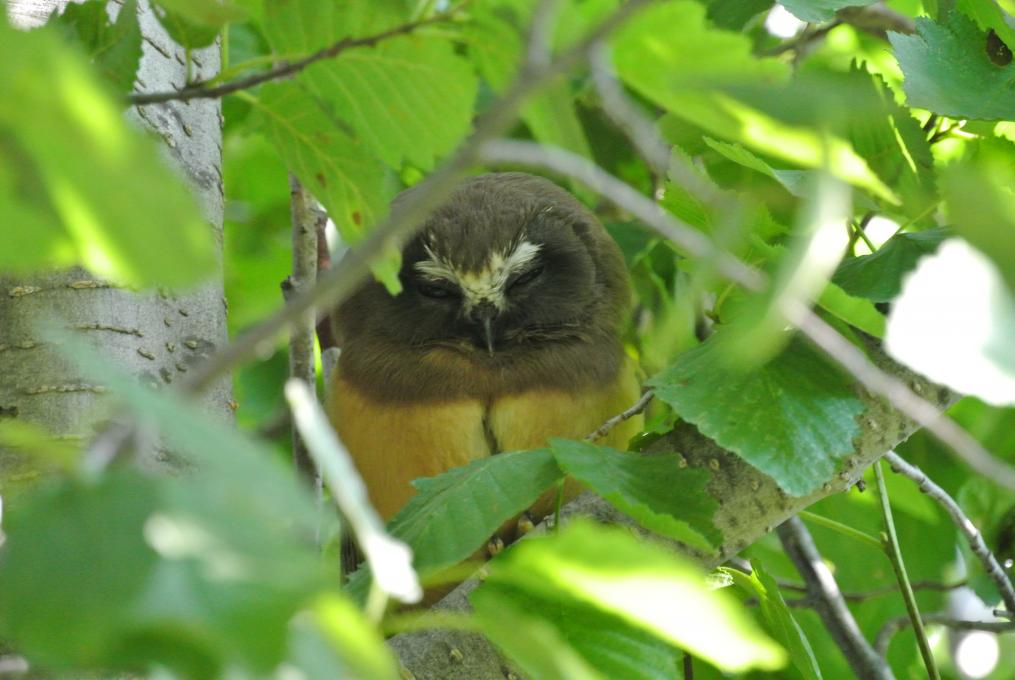
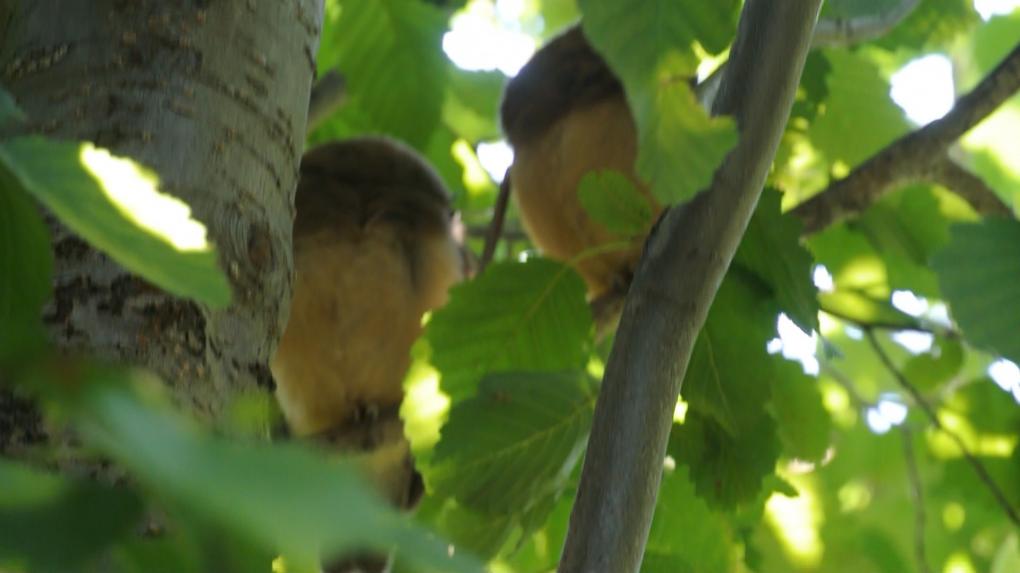 Found these northern saw-whet owls in an aspen tree at South Lake Tahoe, 7/31/14
Found these northern saw-whet owls in an aspen tree at South Lake Tahoe, 7/31/14 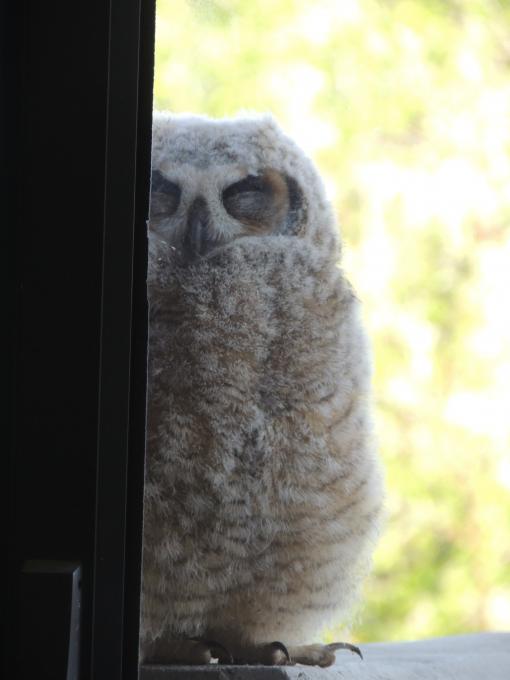
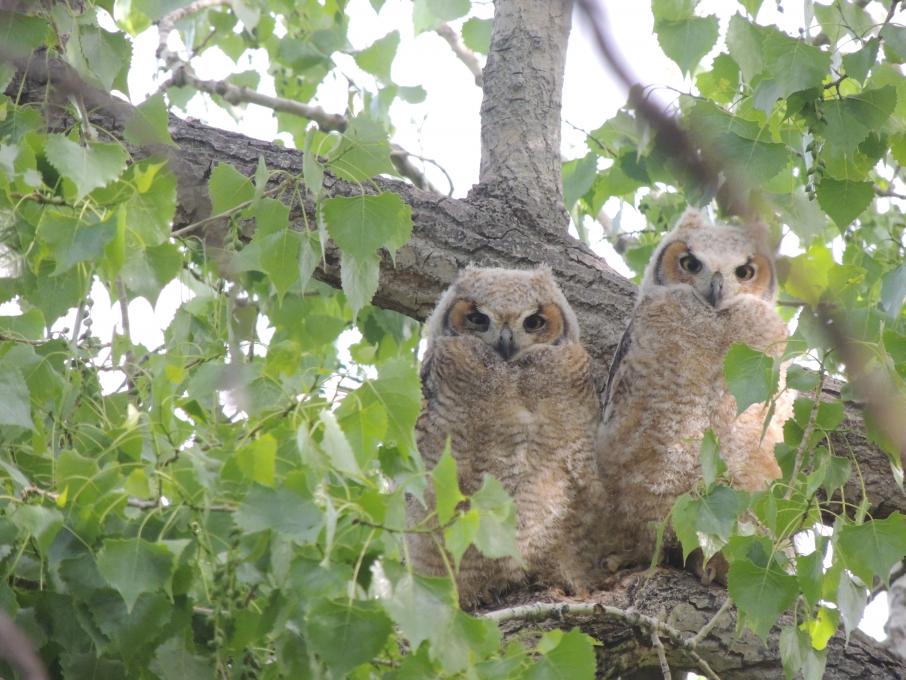
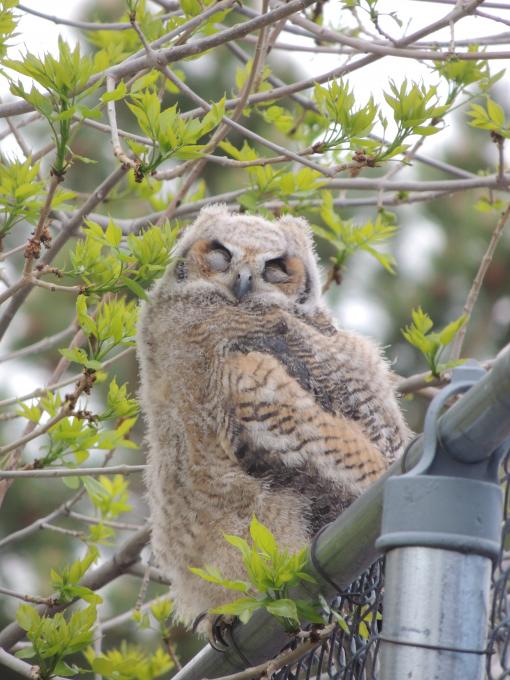 Watching grea horned owls nest on our campus has really helped me understand their life cycle better. These are a few photos of the owlets.
Watching grea horned owls nest on our campus has really helped me understand their life cycle better. These are a few photos of the owlets.  Baby of the Short-eared Owl in the Sabana de Bogotá, Colombia
Baby of the Short-eared Owl in the Sabana de Bogotá, Colombia 

